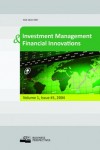An evaluation and comparison of Value at Risk and Expected Shortfall
An evaluation and comparison of Value at Risk and Expected Shortfall
Author(s): Tom Burdorf, Gary van VuurenSubject(s): Economy, Evaluation research, Financial Markets
Published by: ТОВ “Консалтингово-видавнича компанія “Ділові перспективи”
Keywords: market risk; Value at Risk; Expected Shortfall; South Africa; UK; normality; back-testing; historical simulation; variance covariance; Monte Carlo;
Summary/Abstract: As a risk measure, Value at Risk (VaR) is neither sub-additive nor coherent. These drawbacks have coerced regulatory authorities to introduce and mandate Expected Shortfall (ES) as a mainstream regulatory risk management metric. VaR is, however, still needed to estimate the tail conditional expectation (the ES): the average of losses that are greater than the VaR at a significance level. These two risk measures behave quite differently during growth and recession periods in developed and emerging economies. Using equity portfolios assembled from securities of the banking and retail sectors in the UK and South Africa, historical, variance-covariance and Monte Carlo approaches are used to determine VaR (and hence ES). The results are back-tested and compared, and normality assumptions are tested. Key findings are that the results of the variance covariance and the Monte Carlo approach are more consistent in all environments in comparison to the historical outcomes regardless of the equity portfolio regarded. The industries and periods analyzed influenced the accuracy of the risk measures; the different economies did not.
Journal: Investment Management and Financial Innovations
- Issue Year: 15/2018
- Issue No: 4
- Page Range: 17-34
- Page Count: 18
- Language: English

